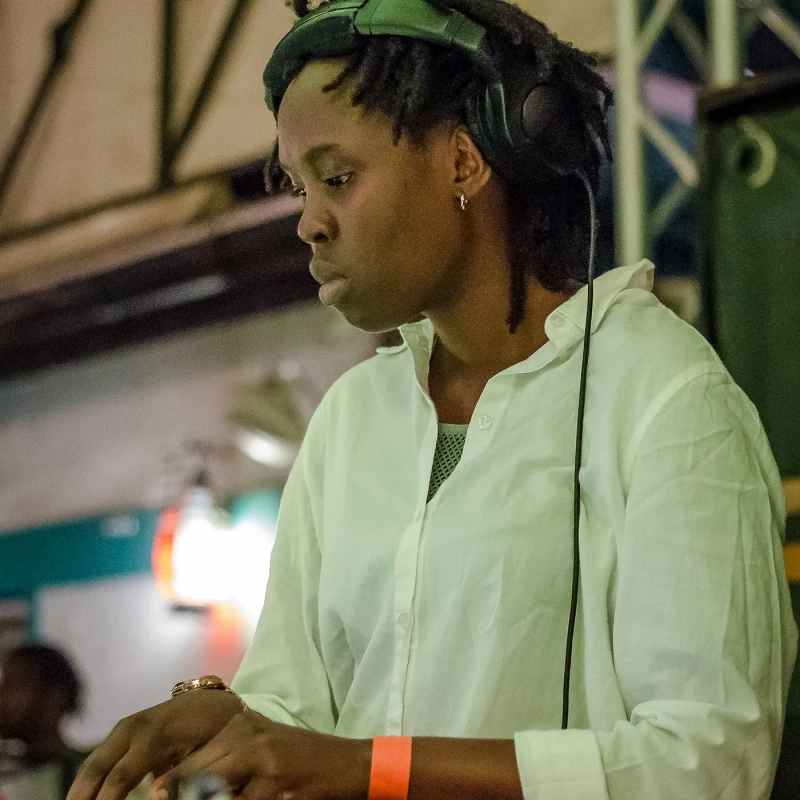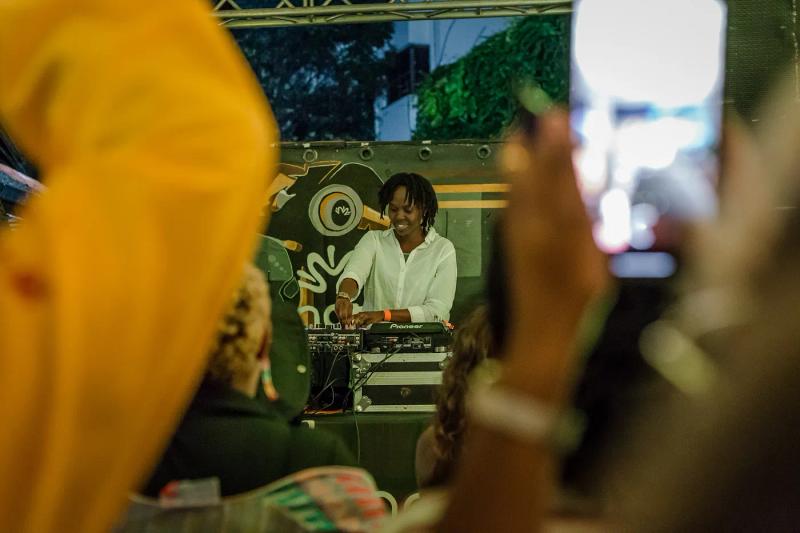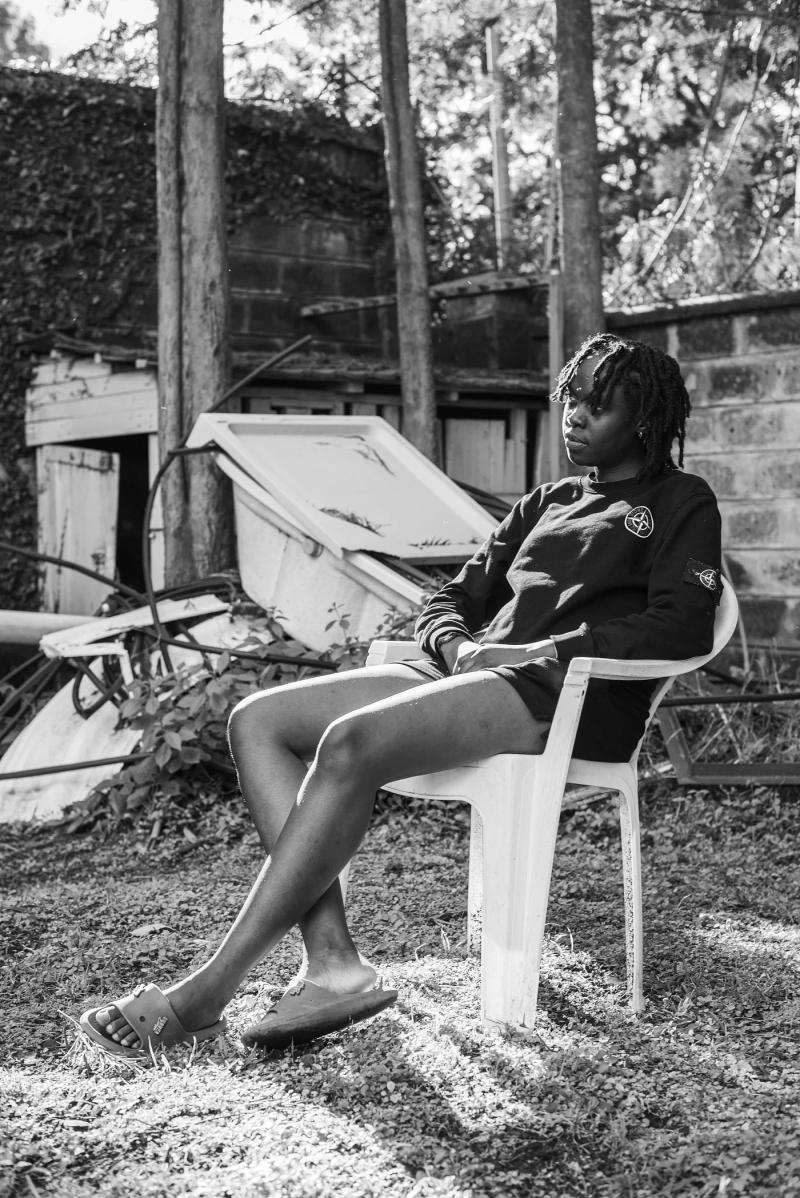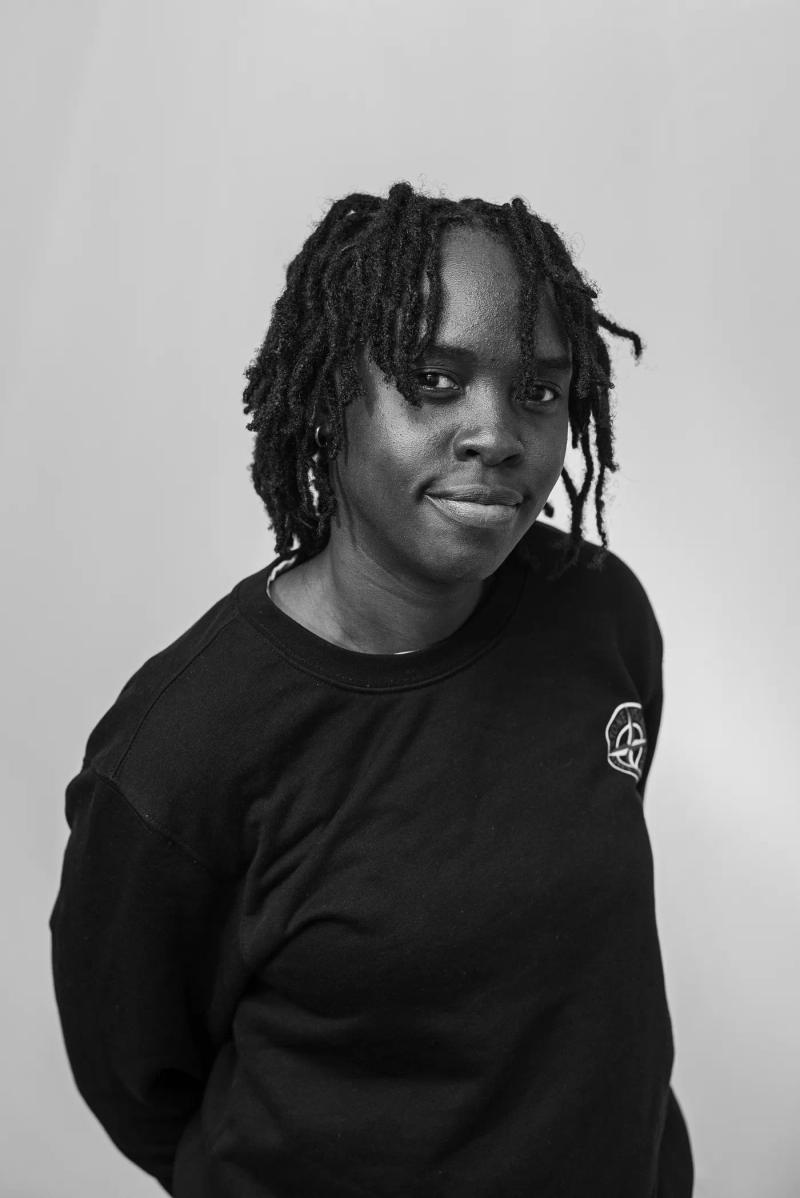in-conversation
In Conversation With Selina Onyando
by Muthoni Kariuki
July 11, 2024

in-conversation
July 11, 2024

Selina is a multi-disciplinary artist, doing it all from deejaying to photography . She is renowned for her versatile DJ sets and unique and refreshing visual style. She has collaborated with various artists including Iyanah Kiragu, Steph Unruly, and Lukorito, helping them bring their visual ideas to life.
I’d like to think of myself as a dreamer. There are many things I’d want to achieve in this lifetime, so I try to do everything I possibly can to realize those dreams before my time here ends. I like to dabble in a bit of everything. I believe that truly defines me
How did your journey with music, specifically Deejaying, start?
I’ve actually never said this out loud. So a few years ago, I think maybe 2019, I was listening to quite a bit of music and I created a YouTube folder, playlists and I think it’s called “I Will Do It or I Can Do It”, something along those lines and I would keep adding my favourite tracks because in my mind at some point I knew that I would be able to share this with the world as a DJ. Then last year or the year before, I interacted with Santuri Electronic Music Academy for the first time and I took the production course. When I started the production course, it was challenging. I’m not going to lie. I started to realise that listening to music and making music are two different things. Though when they rolled out, I still had the intrigue of DJing. I remember during the pandemic, there was a place we used to hang out and have impromptu sets and I always used to be so intrigued but also so scared that I would never try. So when this opportunity came up with Santuri, I knew this was my chance and I had to take it.
It also came at a time when I was transitioning a lot in terms of my style as a photographer. During COVID, I started to realise that being a street and daily life photographer wasn’t going to cut it because I couldn’t document that. I could not be outside and my eyes had changed completely. I started to think maybe the best thing I can do even as I transition to this new space of photography visually is to be inspired by something else. I’m starting to see that it’s very different from photography despite them both being artistic mediums but it’s been a great journey so far.
You were part of the Kilele Summit program that happened in February this year.How was your experience and what were the key takeaways from that event?
Oh that was a great opportunity actually. For context, Santuri has been part of a project together with Braid Fund where they are amplifying sounds from the Kenyan coast and the East African coast at large. Basically, they are archiving a lot of music that has the potential to disappear if it’s not archived. When Santuri reached out to me with a brief, they did mention that it would be an opportunity to explore Swahili music, coastal music from East Africa. I sat for quite a bit of time with the brief because I did not want to do an injustice to the artists who were going to perform. After all,they had come all the way and they were doing a lot of call-and-response type of music that’s very heavily associated with the Mijikenda community in the coast.
When I was digging for that particular assignment I really wanted to bring out the heart of the project but also respectfully reinterpret my view of that music so that the artists who I was performing with did not feel offended. I started by looking at a lot of older East African coastal music stuff from as far back as the 50s, stuff from Zanzibar, Mzee Ngala, who is one of the OGs in the coastal music game.
At the same time, I wanted to reinterpret that in my own ear. Some of the elements that I hear in that traditional sound are also in modern sounds and that could be by way of flips or some samples rather that have very great drum patterns that you hear a lot in that type of music. So I wanted to bring that sound, some call and response patterns and reinterpret it or show what my view of that music now is.
I spent quite a bit of time going back and forth with the duration of that project. I think my Spotify playlist for that ended up being about 60 songs or so and then I sat down with that and then I now cut it down significantly.
Initially, I thought I was supposed to play for a continuous one hour set but then it ended up being split three ways. So that was also challenging because then I had to figure out when between the artist’s performance I should bring what part of the set and all that.
All in all it was a beautiful challenge. I was very happy with the result. I wish there was a bigger audience, a lot of people missed too much of that but I had a great time and really that’s the one thing I enjoy the most about being a DJ is the curation process. And it goes back to what I was saying earlier about being able to tell a story. So now carrying that part of my visual work into my music has been the best part of the journey so far.

And photography/film? What drew you to the medium? Did you grow up in a creative environment?
I’d say a lot of my exposure to art was through music. My dad loves music. Some of my influences are from my musical side and I got that from him. I am very privileged to have parents who are very welcoming of the pursuits I choose to take. I remember when I was nine, we were taking a trip to Naivasha and we stopped by Nakumatt Mega, that’s now Carrefour, and my mom bought me my first camera. It was 999 shillings and it came with film. I still have it today and I still shoot with it, but I’d say I was intrigued by the process from a very young age. Also when I was in high school, I got to interact with art quite a bit with photography as a medium, you know, being exposed to people who are part of the school magazine and having their gear on them quite regularly. So that also amplified my passion and my interest in photography. So after high school, I took that up. I was also privileged enough to be in a community of people who are as accepting, as welcoming and as intrigued by the things that intrigued me. So I would say it started from a young age, but I’m happy to see myself evolve as a visual artist from then till now.
Has there been a particular photograph or project you’ve taken that has challenged your perception of the world or yourself?
Yes, definitely. My favourite project to date is “Malindi-ism” which I worked on in 2019. It was a challenging year for me, confronting personal growth and change. Later in the year, I got a chance to do my attachment in Malindi at the Law courts, and I lived there for three months. It really allowed me to integrate myself fully into the community. I met a lot of people there, heard their stories, and lived with them like siblings. These are people that I still speak to today, even though we are so far apart from each other. I think allowing myself to be welcomed in that space and seeing life through their eyes was just something I never thought I ever would experience. So experiencing that and being able to translate that into photographs, both in film and in digital was just an exceptional experience for me.
Do you feel there’s a difference in the way you approach photographing men versus women?
Initially I found a preference with photographing men compared to photographing women or non-binary folk. I think it could be something that comes from the fact that a lot of my time is spent around men, my brothers, my cousins, my friends, my collaborators.
So I found a certain comfort. I guess it also comes with the confidence that men have behind a lens compared to women. I think there’s a certain vulnerability that comes with photographing women, which doesn’t necessarily have to be a bad thing.
So I would say, maybe I had that preference back then. However, of late, I have been enjoying working with female artists. I did some work with Steph Unruly. She’s a long-time collaborator and friend and I’ve known her since I was in high school. I’ve also worked with Iyanah Kiragu and when we first shot Iyanah’s “ Mr. Sneaky Link” cover, we were just finding our footing as collaborators. Now when we go back to work and see what we’re doing with Truth and her new album, we’re on the same page and that comes with time.
Then you have people like Mr.Lu and Lukorito who just gel so perfectly. With them, I find that most times they come to me and they’re like, hello, this is what I’m working on. How can we go about the images, as opposed to now leaving it all to me and it’s a combined effort.
However, I would say, all in all, the one thing I’ve learned from my work is that regardless of who I’m photographing, I love to have a rapport with the person. I want us to connect on a level that transcends gender , because I find it much easier to see that person through my eyes when I know them. And it’s something I always tell people.
What is your creative process from the point where you have an idea to the point where you take the photo?
Initially back when I focused more on street and daily life photography, my process was very spontaneous. I would take photos on my phone whenever a frame caught my eye, then I would come back to it and edit it in VSCO and bring it to whatever platform or choose what to do with it.
However, I have been adopting a new approach for the past year and a half that I’m really enjoying. First I want to sit down with the artists or collaborators, then hear what they’re thinking or consuming. From those multiple conversations, I sort of get a sense of the type of person they are and why this project is important to them. From there, I proceed to start mood boarding, I will sit down and put together the mood board. This could involve different elements from the framing to the lighting and colour, and then there’s a narrative that accompanies all that. Why did we get here? What is the motivation for this approach?
Once I have all that down, it allows me to have a foundation that I can keep editing with the collaborator or even just by myself. Once that’s done, I like to sit also with the technical bits on my own, especially very close to the shoot dates. I’ll start to think about the additional gear I need. What does operating the lights mean if I have to do that? Are there any other cool, quirky things I can do or add? Then on shoot day, it’s really just to make sure that everyone is comfortable. Shoot day, comfort is the most important thing and they’re having a good time, we’re on the same page and just have fun with it.
The one thing I also want to add is sharing. Once the process is over, being able to share on my own platforms and my website. We just dropped ‘Agent Mgumbe 3’ with Lukorito. So I think it’s also an opportunity for me to now share with people, this is how we got here.

What are things that you feel should be developed in the photography scene in Kenya?
The one thing I would like to see change and I think it has also been a challenge to me is using the visuals to tell stories. You could go to an event and take a bunch of pictures and it’s cool, or you could do some headshots for someone and it’s cool because the pictures are nice. However, being able to tell a story behind that and build it into something that has a solid narrative is something different. Being able to show that we shot it like this because of this and we chose this approach because of this. You will find that some photographers are doing it, but they’re probably not saying that as eloquently as they should. So they have a vision, they know how they landed to a certain point, but they’re not sharing that process with the world. It’s something that I’m hoping to do in the next few projects that I’m working on and I’d like to see that aspect grow in Kenyan photography as well.
There’s a collaborative spirit in fashion photography. How do you develop a rapport with models and stylists to bring your creative vision to life?
Yeah, I think it’s just being able to have an understanding with each other because when I started shooting, I was doing a lot of stuff on my own. You’ll see most of my older work is just my daily life street photography. But last year, I made the conscious decision to collaborate more and you’ll definitely find some stumbles along the way. I know when we first did the Penny Mbili Mizizi collection shoot last year, it took us quite a while to get to a point where we’re like, okay, this is where we want to be. I’ve allowed myself to learn from those mistakes, to learn from those difficult shoots and to be like, okay, now when we’re collaborating, I want to sit down with the artist or stylist, I want to choose or work with a set designer who I feel I resonate with on a personal level. So I guess it’s just, that’s my approach to collaboration.I want to know someone well enough, like I want to work with people I can sit down and have a beer with and we can have a conversation. I feel comfortable around them and they feel comfortable around me. So I think that’s what I would say about that.
What is the perfect photograph for you?
The perfect photograph for me is one that has many layers to it in terms of framing, a frame within a frame within a frame but it also respects the rule of thirds, where you split the photograph to three and you can use any of the thirds to draw in the viewer. But I really like pictures where there’s a frame inside a frame inside a frame. I’m also a big colour fiend. I think you’ll notice a lot of my work color-wise is inspired by film photography. So you could say maybe what you would get in terms of colour from the 70s or 60s. I like that older grainy feel. So something that someone would look at and they would not know which era that picture was taken in unless they see elements like a phone or a laptop or a car. I guess that’s also something that really intrigued me about the movie Salt Burn because you couldn’t tell what era it was shot in until much later when you see the TV and you’re like oh okay this is this era. But yeah those are the things that intrigue me about pictures and that’s what I look for in a good picture when I’m shooting.
What other photographers inspire your work?
Quite a few. I’d say locally my first source of inspiration has to be Sarah Waiswa (Lafrohemien), a brilliant photographer.I think her work is exceptional. Then there’s Steph McCurry, a brilliant documentary photographer. He’s been around for ages. He understands the rule of a frame within a frame perfectly and his composition is so immaculate.
There’s also Malick Sidibé who I feel is just an OG. Probably everyone has Malick Sidibé on their rap sheets. I think a lot of photographers would resonate a lot with his work. Great black and white stuff he really is just so brilliant. A filmmaker who I also resonate with is Senegalese artist,Ousmane Sembène,he has made quite a few films back in the day. Some would say he’s the godfather of African film. He made a film called Black Girl that I watched and I was in awe. The way he tells the story visually and also just the narrative itself is incredible. Those are my top four but that list probably changes from time to time.

About the “Quarter Past Nine” Project on your blog: What specific aspects of being stuck in a loop did you explore in your self-portraits?
Quarter past nine was done as a project that I did with Canon for a workshop that Sarah Waiswa was running and the objective of the workshop was to be able to use pictures to tell a story that you can carry people through with. It could be visuals only or it could have words to accompany it. When I was working on that project I was in a really horrible place because I was in a job that I did not like. I’d lost interest in work, I’d lost interest in my creative work and I was just stuck in this nine-to-five loop, where you wake up, get ready, stare at a screen the whole day, shower, go to bed, wake up, do it again. I wanted to visually articulate that day, what it looks like when you’re in a loop and you can see in the pictures where there are self-portraits that I was very out of it. That was also the first time I’d ever explored a self-portraiture project. Normally I’m on the other side, I don’t like to be on this side but I wanted to challenge myself because most times these stories are relatable when people can see themselves in what you’re portraying. So that’s what I tried to achieve with those, quite a few of the self-portraits when we were reviewing them in the workshop guys were like I don’t know about these so by the time I got to some that I felt a lot of people resonated with I know I also had that feedback where they’re like yeah I can feel this emotion for myself when I look at that picture.
What do you hope people get from your work?
I hope people get inspired to just keep doing the stuff that they do. For me some of these things are what keep me sane, being able to make music, being able to take photographs and sometimes I might not also see it but it really is an expression of where I am in life at a certain point. So I would hope that when people look at those pictures first they feel nostalgia for a sense of home, especially when they’re looking at the streets daily life stuff that they look and say I feel like I’m looking at home, I feel some familiarity in my pictures but I also hope that my work ethic encourages people to keep creating and in any art shape or form to allow themselves to be beginners and to just run with it.
What advice would you give to aspiring photographers?
It would be just do it. It doesn’t matter what gear you have. When I started shooting in 2015 before I bought my film camera I was shooting on my phone.
I’ve never been a believer in you having to have the newest gear or the latest stuff to create. I think a lot of people think that you can’t do anything while you’re not inspired.
I always imagine that a lot of people create when they are not creating they are consuming because that’s what I do. I consume a lot of art. I allow myself to be inspired by other people. So reading and watching, it could be things as simple as the news because then you’re allowed to tell your own story or perception from that. So I would encourage them to just start. Don’t worry about the gear and consume art. Read about even some of the non-technical stuff. How to frame what you’re trying to do, composition, all that stuff. It really helps and the last and most important thing is to find a community that cares about your work and cares about the things you care about so that you know you’re not going through the learning curve alone.
What do you plan for the future in both aspects?
I think it’s also important for me that you ask that question because I’m in a place where I work from nine to six. I go to the office thrice a week. I love my job. I really do and I hope that one day I’ll reach a point where I can merge all my interests into one. Where I will be able to work strongly as an advocate for policy in the creative economy in Africa and to be thought of as a thought leader in this space and I also want that to come with the freedom to be able to create, to have the time to create and collaborate. Because I’m doing this on the other side.
In terms of photography, the one thing I really want first for myself is new gear. I’m halfway there in terms of saving. So I’m hoping that by the end of this year or early next year, I’ll have new gear. Just so I have a different feeling in my hands. I would really like to keep collaborating with people, have new experiences. I’ve really been enjoying doing behind the scenes type of work. So I’m hoping to work with more Kenyan artists. Whether it is covers or just telling the story visually. It could be anything and I hope that in the next few years that will transcend to artists outside East Africa. So just documenting the music scene more. That’s a call for anyone looking to collaborate!
In terms of DJing, one thing I’m learning about DJing, and I’m also learning it because of my experience in photography, is that everything happens in its own time. I’m not feeling any particular pressure to be somewhere or to be on a certain stage or to play certain gigs. I know that people who know me and meet me understand the type of work I do. Because of that, they will seek me out for that, or I will seek them out for that. So with DJing, I’m really taking it easy. I’m enjoying the journey so far.I don’t want to be in a situation where I am playing a certain genre of music, because that’s what everyone is doing or that’s what’s popular. I want to keep true to my roots and to the type of music I enjoy doing. However, I would like to play Beneath The Baobabs but I’m not in any particular rush. I’m happy with the journey so far.